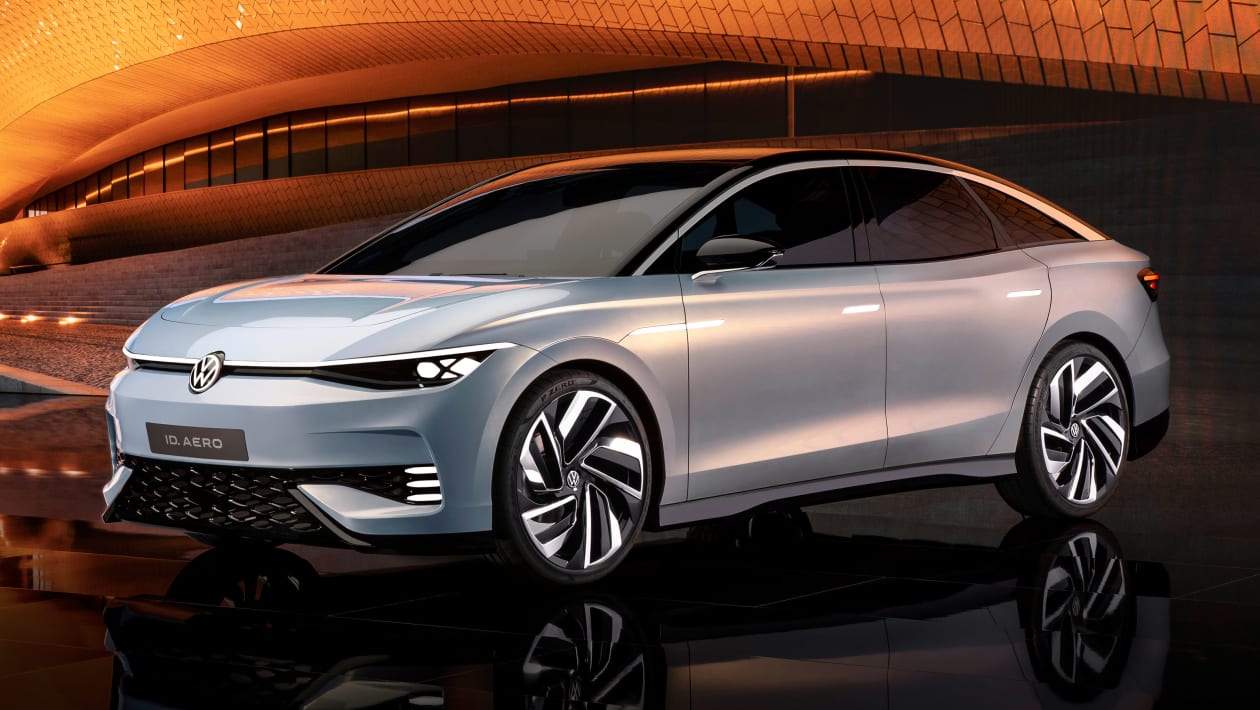
Volkswagen is firmly setting its sights on the likes of the Tesla and Polestar with its new ID. Aero and as these latest images show it’ll retain plenty from the ID. Vizzion concept.
The ID. Vizzion concept was first shown at the 2018 Geneva Motor Show, featuring design traits that have now become a staple of VW’s all-electric ID range. We’ve spied the new ID. Aero testing before and this production concept model shows that not much will change for the final iteration.
As we expected, the front of the ID. Aero will adopt a similar face to the rest of VW’s ID range. The low nose helps aerodynamic efficiency and the headlight arrangement, coupled with the light bar split by the VW badge, is reminiscent of the ID. Buzz and ID.4. The side air intakes below the headlights incorporate three individual fog lights and the uplift on the lower part of the bumper gives the ID. Aero some aggression. The thin grille, flush-fitting door handles and other aerodynamic features help lower the drag coefficient to 0.23.
The curved roof is joined by a new chrome strip running from the A-pillar to the D-pillar, accentuating the car’s shape. A shoulder-line crease also runs the length of the body, something that’s become a trademark design cue of the German firm’s electric models. The diamond-cut 22-inch wheels are a new design, too.
At the back there’s a full-width light bar with some intricate rear LED clusters, the light-up VW badge on the bootlid isn’t likely to make production in Australia. A small diffuser also mimics the one seen on the prototype ID Aero.
Volkswagen has previously promised that the production saloon would be capable of 600km on a single charge, but since then ‘enhancements’ for the MEB platform have been revealed, which will underpin the new ID. Aero.
At almost 5 metres in length, the ID. Aero is much longer than either the Tesla Model 3 or Polestar 2 – it’s actually not far off the Model S. This extra space means a new 77kWh battery and motor system is easily integrated, helping deliver a maximum range figure of 620 kilometres. Recharging will be raised from 150kW to 200kW with the new MEB architecture, so a 10-80 per cent top-up should take less than half an hour.
Performance should be increased too, with the potential for a hot four-wheel-drive GTX version offering a 0-100km/h time of around 5.5 seconds. The current ID.4 GTX and ID.5 GTX SUVs put out 220kW and 310Nm of torque, and this is the set-up most likely to appear in a GTX variant of the ID. Aero.
Eventually, Volkswagen will also launch an estate version of the ID. Aero, which was previewed by the ID. Space Vizzion concept from the 2019 Los Angeles Motor Show. This car was fitted with a dual-motor electric powertrain, which produces a more potent 250kW, which would align closely with the expected performance of a GTX model.
Inside, we expect the ID. Aero will feature the same compact digital dashboard and 10-inch infotainment system as the rest of Volkswagen’s MEB-based models, with the potential for a larger 12-inch screen to feature on high-spec editions.
The ID. Aero will be brought to Chinese markets first in the second half of 2023. This will be followed by North American and European markets. Volkswagen Australia is yet to confirm timing for an introduction of its electric ID range locally, however, it hopes to begin launching models next year.
Alastair Crookes



